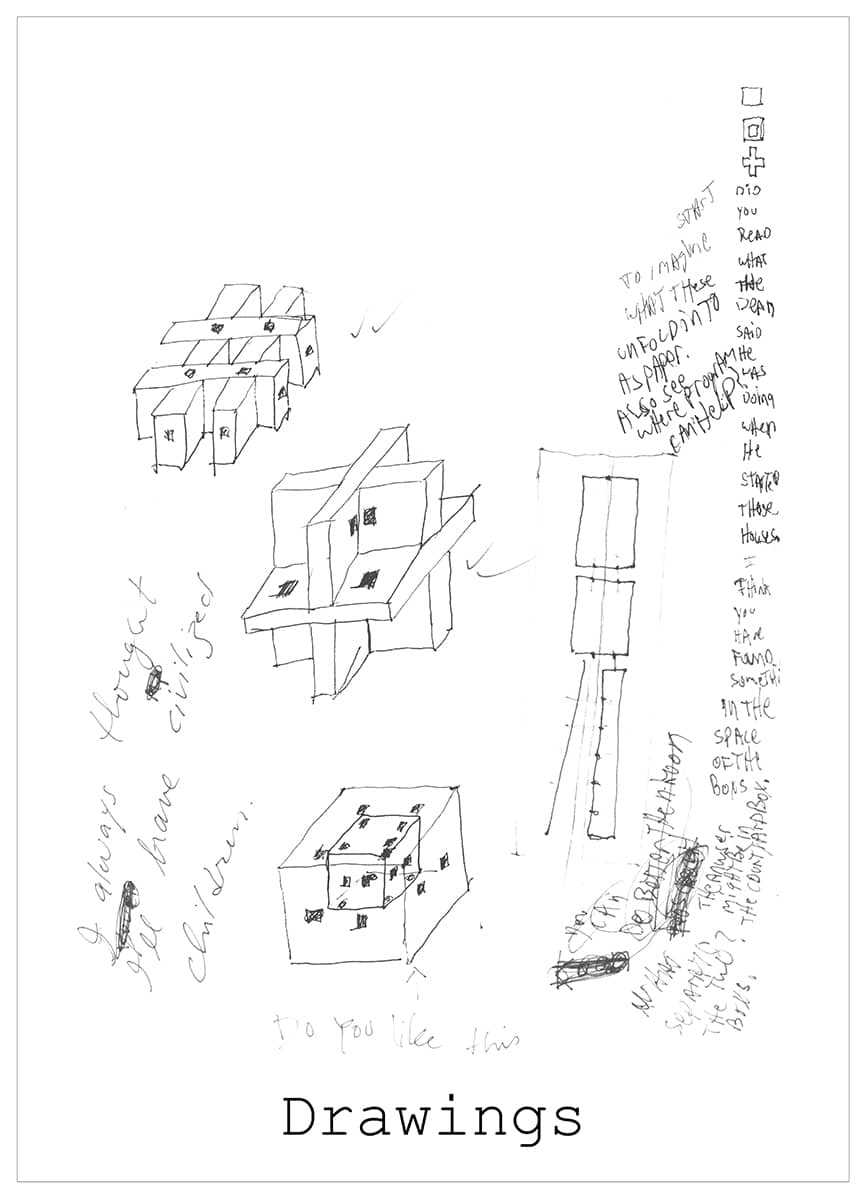Landscape of the Gaze
-

Camera Obscura with 8 pinholes, 1990, Basswood, Plywood and Aluminum Sheet, 9”x 9”x 5”
Photograph by mstudioofficialFinisher’s House/ an inside time/ an outside time, 1990, Thesis Table of the Thesis class of 1991 with 30 camera obscuras in Irwin S. Chanin School of Architecture of The Cooper Union’s Lobby,
74”x 62”x 42”, Wood and Steel Tablea flat, luminous and transparent depth /an irreplaceable magic/ the limit of the gaze approaching from beyond opacity to the back of opacity/ the impossible/ the miracle
1990, 180 Pieces of Film, 63”x 52”Landscape 1, 1990, 6 Layers of Film, 8”x 8”
Landscape 2, 1990, 6 Layers of Film, 8”x 8”
Landscape 3, 1990, 6 Layers of Film, 8”x 8”
Landscape 4, 1990, 6 Layers of Film, 8”x 8”
Landscape 5, 1990, 6 Layers of Film, 8”x 8”
Landscape 6, 1990, 6 Layers of Film, 8”x 8”
Landscape 7, 1990, 6 Layers of Film, 8”x 8”
Landscape 8, 1990, 6 Layers of Film, 8”x 8”
Landscape 9, 1990, 6 Layers of Film, 8”x 8”
Landscape 10, 1990, 6 Layers of Film, 8”x 8”
Landscape 11, 1990, 6 Layers of Film, 8”x 8”
Landscape 12, 1990, 6 Layers of Film, 8”x 8”
Landscape 13, 1990, 6 Layers of Film, 8”x 8”
Landscape 14, 1990, 6 Layers of Film, 8”x 8”
Landscape 15, 1990, 6 Layers of Film, 8”x 8”
Landscape 16, 1990, 6 Layers of Film, 8”x 8”
Landscape 17, 1990, 6 Layers of Film, 8”x 8”
Landscape 18, 1990, 6 Layers of Film, 8”x 8”
Landscape 19, 1990, 6 Layers of Film, 8”x 8”
Landscape 20, 1990, 6 Layers of Film, 8”x 8”
Landscape 21, 1990, 6 Layers of Film, 8”x 8”
Landscape 22, 1990, 6 Layers of Film, 8”x 8”
Landscape 23, 1990, 6 Layers of Film, 8”x 8”
Landscape 24, 1990, 6 Layers of Film, 8”x 8”
Landscape 25, 1990, 6 Layers of Film, 8”x 8”
Landscape 26, 1990, 6 Layers of Film, 8”x 8”
Landscape 27, 1990, 6 Layers of Film, 8”x 8”
Landscape 28, 1990, 6 Layers of Film, 8”x 8”
Landscape 29, 1990, 6 Layers of Film, 8”x 8”
Landscape 30, 1990, 6 Layers of Film, 8”x 8”
a concave opacity/ the embrace/ the mirror, 1990, 180 Pieces of Gelatin Silver Prints, 144”x 80”
Works in Cooper Union, School of Architecture’s Lobby, 1990
The kind that thinks he is the only one who has experienced it, 1991, Camera Obscura with 16 pinholes, 9”x 9”x 5”, Basswood, Plywood and Aluminium Sheet
Courtesy of Irwin S. Chanin School of Architecture Archive of The Cooper Union, Photograph by Steven HillyerThe kind that thinks he is the only one who has experienced it, 1991, The image is made of 10 unfolded sides of the interior of the box, Gelatin Silver Prints, 16”x 24”
Courtesy of Irwin S. Chanin School of Architecture Archive of The Cooper Union, Photograph by Pro-LabThe kind that glorifies, 1991, Camera Obscura with 8 pinholes, 9”x 9”x 5”, Basswood, Plywood and Aluminium sheet
Courtesy of Irwin S. Chanin School of Architecture Archive of The Cooper Union, Photograph by Steven HillyerThe kind that glorifies, 1991, The image is made of 14 unfolded sides of the interior of the box, Gelatin Silver Prints, 16”x 24”
Courtesy of Irwin S. Chanin School of Architecture Archive of The Cooper Union, Photograph by Pro-LabThe kind that becomes incredible, 1991, Camera Obscura with 8 pinholes, Basswood, Plywood and Aluminium Sheet, 9”x 9”x 5”
Courtesy of Irwin S. Chanin School of Architecture Archive of The Cooper Union, Photograph by Steven HillyerThe kind that becomes incredible, 1991, The image is made of 34 unfolded sides of the interior of the box, Gelatin Silver Prints, 16”x 24”
Courtesy of Irwin S. Chanin School of Architecture Archive of The Cooper Union, Photograph by Pro-LabThe kind that narrates, 1991, Camera Obscura with 16 pinholes, 9”x 9”x 5”, Basswood and Aluminium sheet
Courtesy of Irwin S. Chanin School of Architecture Archive of The Cooper Union, Photograph by Steven HillyerThe kind that narrates, 1991, The image is made of 7 unfolded sides of the interior of the box, Gelatin Silver Prints, 16”x 24”
Courtesy of Irwin S. Chanin School of Architecture Archive of The Cooper Union, Photograph by Pro-LabThe kind that never forgets, 1991, The image is made of 4 unfolded sides of the interior of the box, Gelatin Silver Prints, 16”x 24”
Courtesy of Irwin S. Chanin School of Architecture Archive of The Cooper Union, Photograph by Steven HillyerThe kind that never forgets, 1991, Camera Obscura with 16 pinholes, 9”x 9”x 5”, Basswood and Aluminium sheet
Courtesy of Irwin S. Chanin School of Architecture Archive of The Cooper Union, Photograph by Pro-LabThe secret carrier, 1991, Camera Obscura with 2 pinholes, 9”x 1”x 5, Basswood, Plywood and Aluminium Sheet
Courtesy of Irwin S. Chanin School of Architecture Archive of The Cooper Union, Photograph by Steven HillyerThe secret carrier, 1991, The image is made of 6 unfolded sides of the interior of the box, Gelatin Silver Prints, 16”x 24”
Courtesy of Irwin S. Chanin School of Architecture Archive of The Cooper Union, Photograph by Pro-LabThe kind that walked through it with closed eyes. They heard the disaster happen and they are happy they did not see it, 1991, Closed Box, 9”x 9”x 5”, Basswood and Plywood
Courtesy of Irwin S. Chanin School of Architecture Archive of The Cooper Union, Photograph by Steven HillyerDollar Sign, 1999, Camera Obscura with 18 pinholes, 9”x 9”x 5”, Basswood and Aluminium sheet
Vertical Dollar Sign Self-Portrait, 1999, Gelatin Silver Prints, 40”x 16”
Photograph by mstudioofficialHorizontal Dollar Sign Self-Portrait, 1999, Gelatin Silver Prints, 38”x 38”
Photograph by mstudioofficialDiagonal Dollar Sign Self-Portrait, 1999, Gelatin Silver Prints, 39”x 31”
Photograph by mstudioofficialTower, 2004, Camera Obscura with 76 pinholes, Basswood and aluminium sheet,
18 ½”x 9 ¼”x 1 ¾”Tower Self-Portrait, 2004, The image is made of 6 unfolded sides of the interior of the box, Gelatin Silver Prints, 48”x 55”
Photograph by mstudioofficial -

Untitled, 1990-1991, Watercolor on Paper, 10”x 13”, Photograph By mstudioofficial
Untitled, 1990-1991, Gouache on Mylar on Black Paper, 9”x 9”, Photograph By mstudioofficial
Untitled, 1990-1991, Gouache on Mylar Glued on Black Paper, 5”x 9”, Photograph By mstudioofficial
Untitled, 1990-1991, Gouache on Mylar Glued on Black Paper, 9”x 9”, Photograph By mstudioofficial
Untitled, 1990-1991, Gouache on Mylar Glued on Black Paper, 5”x 9”, Photograph By mstudioofficial
Untitled, 1990-1991, Ink on Paper, 7”x 8”, Photograph By mstudioofficial
Untitled, 1990-1991, Ink on Paper, 10”x 8”, Photograph By mstudioofficial
Untitled, 1990-1991, Ink on Paper, 10”x 8”, Photograph By mstudioofficial
Untitled, 1990-1991, Ink on Paper, 10”x 8”, Photograph By mstudioofficial
Untitled, 1990-1991, Ink on Paper, 7”x 8”, Photograph By mstudioofficial
Untitled, 1990-1991, Ink on Paper, 10 1/2”x 8”, Photograph By mstudioofficial
Untitled, 1990-1991, Ink on Paper, 10 1/2”x 8”, Photograph By mstudioofficial
Untitled, 1990-1991, Ink on Paper, 10 1/2”x 8”, Photograph By mstudioofficial
Untitled, 1990-1991, Ink on Paper, 10 1/2”x 8”, Photograph By mstudioofficial
Untitled, 1990-1991, Ink on Paper, 10 1/2”x 8”, Photograph By mstudioofficial
Untitled, 1990-1991, Ink on Paper, 10 1/2”x 8”, Photograph By mstudioofficial
Untitled, 1990-1991, Ink on Paper, 8 1/2”x 8”, Photograph By mstudioofficial
Untitled, 1990-1991, Ink on Paper, 10 1/2”x 8”, Photograph By mstudioofficial
Untitled, 1990-1991, Ink on Paper, 10 1/2”x 8”, Photograph By mstudioofficial
Untitled, 1990-1991, Ink on Paper, 10 1/2”x 8”, Photograph By mstudioofficial
Untitled, 1990-1991, Ink on Paper, 10 1/2”x 8”, Photograph By mstudioofficial
Untitled, 1990-1991, Ink on Paper, 10 1/2”x 8”, Photograph By mstudioofficial
Untitled, 1990-1991, Ink on Paper, 10 1/2”x 8”, Photograph By mstudioofficial
Untitled, 1990-1991, Ink on Paper, 10 1/2”x 8”, Photograph By mstudioofficial
Untitled, 1990-1991, Ink on Paper, 10 1/2”x 8”, Photograph By mstudioofficial
Untitled, 1990-1991, Ink on Paper, 10 1/2”x 8”, Photograph By mstudioofficial
Untitled, 1990-1991, Ink on Paper, 10 1/2”x 8”, Photograph By mstudioofficial
Untitled, 1990-1991, Ink on Paper, 10 1/2”x 8”, Photograph By mstudioofficial
Untitled, 1990-1991, Ink on Paper, 10 1/2”x 8”, Photograph By mstudioofficial
Untitled, 1990-1991, Ink on Paper, 10 1/2”x 8”, Photograph By mstudioofficial
Untitled, 1990-1991, Ink on Paper, 10 1/2”x 8”, Photograph By mstudioofficial
Untitled, 1990-1991, Ink on Paper, 10 1/2”x 8”, Photograph By mstudioofficial
Untitled, 1990-1991, Ink on Paper, 10 1/2”x 8”, Photograph By mstudioofficial
Untitled, 1990-1991, Ink on Paper, 10 1/2”x 8”, Photograph By mstudioofficial
Untitled, 1990-1991, Ink on Paper, 10 1/2”x 8”, Photograph By mstudioofficial
Untitled, 1990-1991, Ink on Paper, 10 1/2”x 8”, Photograph By mstudioofficial
Untitled, 1990-1991, Ink on Paper, 10 1/2”x 8”, Photograph By mstudioofficial
LIGHT
Inside each camera obscura every surface is covered with film. When light enters the box through a pinhole, it makes an inverted image of the outside on its opposite wall. This is a photographic image since light has passed through a pinhole. There are as many images of the outside as there are pinholes.
The camera is exposed to light for about one hour. Once light has entered the box, the interior surfaces reflect the light and record the events inside the box. Since there are no pinholes in the interior of the box, these interior images are produced solely by the action of light on film, therefore creating photograms.
The photographic images of the outside and the photograms of the inside are simultaneously recorded on all the interior surfaces.
TIME
The box sees and records the inside and the outside in two different ways which creates a distinction between two qualitative times: “outside time”, the time contained in the images of outside, and “inside time”, the time contained in the photograms of inside.
Since the box records all that occurs for a long and continuous duration, the image contains a volume of time rather than a section of time as in a film frame or a snapshot.
SELF-PORTRAIT
In the process of seeing and recording the outside and the inside, each box makes a self-portrait. This is an interior self-portrait, the result of how the box sees and records its exterior world and its own interior.
After being exposed to light, the box is taken back to the darkroom where all film is removed from the interior surfaces, developed, and printed. The arrangement of all the many surfaces follows the logic of unfolding and flattening each volume. When all the interior surfaces are unfolded, a map of the interior volume of the box emerges, as if the box was seeing it’s face from inside, similar to the underside of a mask. This multi-sided image contains photographs of the outside, outside time, photograms of the inside, and inside time. Each box is a vessel or a character. It looks at the world and itself in its own specific way. The self-portrait contains a specific truth that is inherent in the program of the camera, and as such these are not good or bad or strong or weak portraits. Every portrait is a true interior self-portrait of the camera that produces it. Each box is the actual body that produces its own portrait. Through the way that it sees, it reveals the boundaries of its outside and the limits of its inside.

